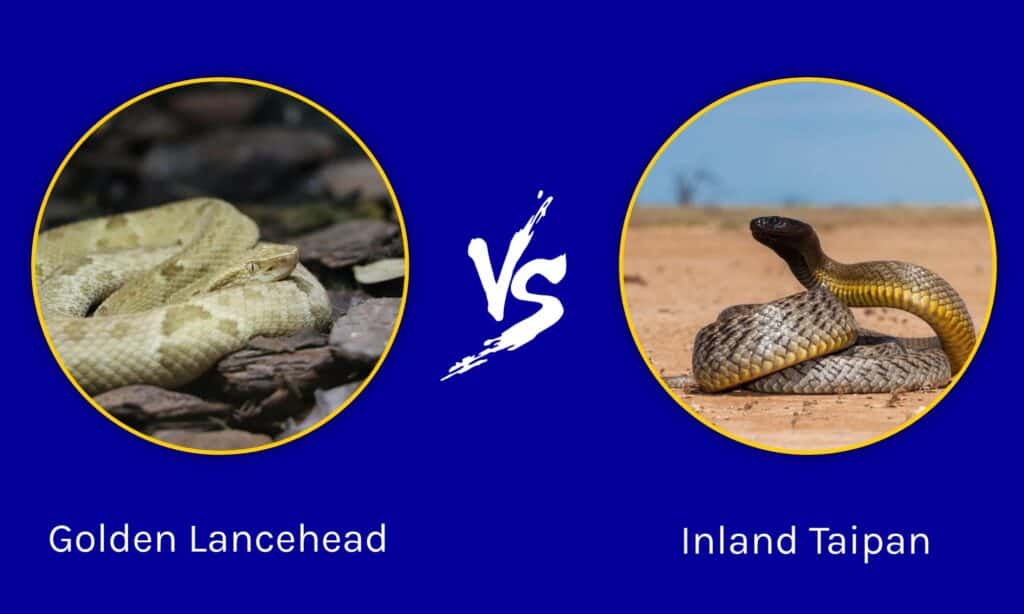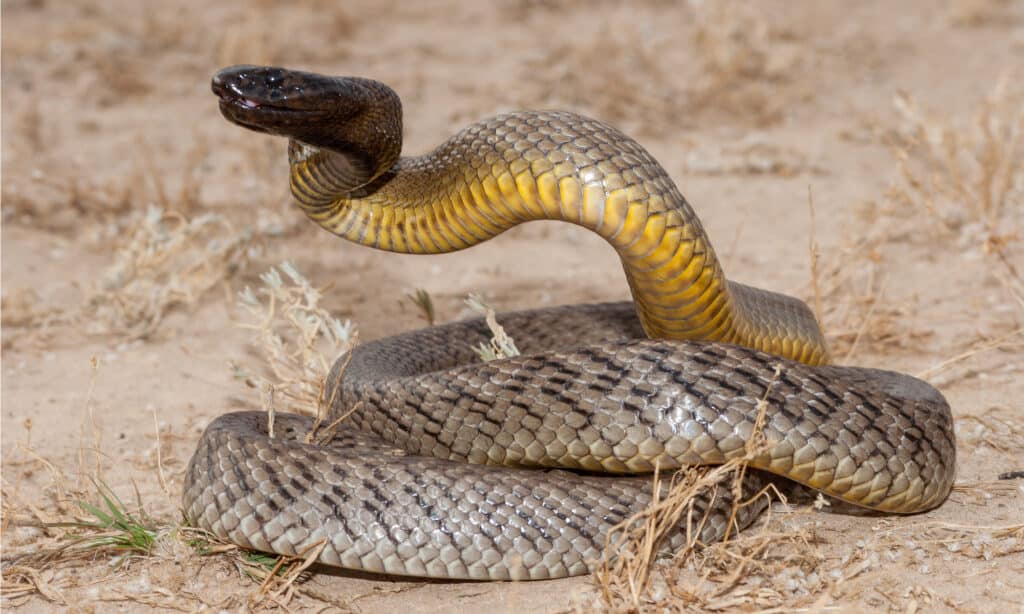Key Points:
- Both the golden lancehead and inland taipan snakes are venomous and neither have been studied very well in the wild due to their elusiveness.
- Inland taipans are more neutral, forest colors, while golden lanceheads range in color from brown to cream with bright colors.
- Overall, an inland taipan would win in a fight against a golden lancehead because of its advantage in both great size and speed, as well as a more potent venom.
Reclusive, dangerous snakes are always interesting to examine, and the golden lancehead and inland taipan are two of the animals that best fit that description. Looking at the golden lancehead vs inland taipan, we can see the differences between them. Although they’re both venomous snakes, they’re unique from one another. So, take a look and learn about what separates these animals from one another and what similarities they possess.
Comparing a Golden Lancehead and an Inland Taipan

| Golden Lancehead | Inland Taipan | |
|---|---|---|
| Size | Weight: 0.5lbs-5lbs Length: 2ft-4ft | Weight: 3lbs-4.4lbs Length: 4ft-6ft, up to 9ft maximum |
| Speed | – 2-5mph | – 5 mph (estimated) |
| Venom | – Hemotoxic venom that kills red blood cells and causes tissue damage – Fast absorption rate – Causes severe necrosis of tissue – Has enough venom to kill ten humans – 5-7% mortality without treatment – 3% mortality rate with treatment | – Considered the deadliest venom in the world with hemotoxin and neurotoxin – 44mg average venom load with 110mg maximum – Capable of killing between 100 and 280 humans with a single bite – Nearly 100% envenomation rate and delivers several bites – 80% mortality rate with no treatment – No data on mortality rate with treatment, but antivenom does exist |
| Coloration | – Yellow, tan, cream – Yellow colors can be quite intense and bright | – Dark tan, brown, green – Head may be darker than the rest of the body |
| Location | – Lives only on “Snake Island”, Ilha da Queimada Grande – 20 miles off the coast of Brazil | – Australia – Interior, central-east portion of the country in remote areas |
The Key Differences Between Golden Lanceheads and Inland Taipans
The key differences between golden lanceheads and inland taipans are their venom potency, size, and colors. Golden lanceheads are yellow snakes measuring up to 4ft with a hemotoxic venom that can kill ten humans in a single bite, and inland taipans are dark brown snakes measuring up to 9ft long and possess a combination of hemotoxic and neurotoxic venom that can kill 280 people with a single bite.
These snakes are incredibly different from one another in many ways, and we’re going to examine the two animals a bit closer to highlight their unique qualities. Only then can we show all their distinguishing factors in great relief.
Golden Lancehead vs Inland Taipan: Size

Inland taipans can grow to a maximum of 9 feet.
©Ken Griffiths/Shutterstock.com
The inland taipan is larger than the golden lancehead. The golden lancehead weighs between 0.5-5lbs and grows between 2-4ft. Meanwhile, the inland taipan measures up to 6ft long and 9ft at its maximum while weighing upwards of 4.4lbs. On average, the inland taipan is longer and heavier than the golden lancehead despite being a rather thin snake.
Golden Lancehead vs Inland Taipan: Speed
The golden lancehead and inland taipan share the same maximum speed. These snakes can both reach speeds of about 5 mph at the maximum. However, neither snake is observed in the wild too often, so their maximum speeds are mostly speculation.
Golden Lancehead vs Inland Taipan: Venom

Inland taipans have a venom that can kill up to 289 people in a single bite.
©Ken Griffiths/Shutterstock.com
The inland taipan has a much deadlier venom than the golden lancehead, but both snakes have venom that is strong enough to kill humans. The inland taipan has a hemotoxic and neurotoxic venom, meaning it issues a double dose of danger. This snake does not deliver dry bites; it always delivers venom.
Untreated, its venom can kill up to 289 people with a single bite. The venom has an 80% or greater mortality rate without treatment, and the snake delivers 44mg of venom on average. The inland taipan rarely stops with a single bite and is known to deliver the most toxic venom of any snake on the planet, specialized to warm-blooded mammals. Needless to say, this is one of the most dangerous animals on the planet.
The golden lancehead has a hemotoxic venom that also increases the uptake of its venom, enhancing the danger from a bite. The snake’s bite has enough venom to kill ten humans, but it’s highly treatable with anti-venom. The mortality rate of this snake’s bite is about 5%-7% without treatment and 3% with treatment. The golden lancehead is dangerous, but treatment is possible. Moreover, it’s almost impossible to encounter this snake.
Golden Lancehead vs Inland Taipan: Coloration
The golden lancehead is a yellow, tan, and cream snake that can exhibit quite bright colors. This snake will stand out from the rest of the trees in which they hide. However, the inland taipan is a darker snake with dark tan, brown, and green colors. The head may be darker than the rest of the body, almost black in some cases.
Golden Lancehead vs Inland Taipan: Location

Snake Island is the only place in the world that is home to the golden lancehead.
©Nayeryouakim / Creative Commons – License
The golden lancehead and inland taipan both live in very remote areas. The inland taipan lives only in the interior of Australia. Specifically, they live in the central-east portion of the country’s semi-arid areas.
Golden lanceheads only live on a small island known as Snake Island, a place 20 miles off the coast of Brazil. The island is quarantined, and the only humans that visit are researchers and members of the Brazilian Navy. Every once in a while, pirates visit Snake Island to take some snake samples and sell them for $30,000 or more!
Both snakes are incredibly reclusive and hard to find, but the golden lancehead is far more remote from humanity.
Diet
Golden lanceheads rely mainly on perched birds for the majority of their sustenance. However, they are known to eat small lizards and will even eat their own kind if desperate enough.
On the other hand, inland taipan are highly specialized to eat mainly small mammals and rodents, especially long-haired rats and house mice, an introduced species.
Golden Lancehead vs Inland Taipan: Who Would Win in a Fight?
An inland taipan would win in a fight. This snake is incredibly fast and agile. It can land a bite on other creatures with ease. That’s exactly what it would do to the golden lancehead. A bite from an inland taipan would overwhelm the smaller snake, killing it in minutes.
Meanwhile, the golden lancehead may not be able to counterstrike after the first bite. Even in the worst case where both creatures sustain a bite, the inland taipan will be the last snake standing.
Sure, the golden lancehead could be the aggressor since the inland taipan prefers to escape from fights. However, even in that case, the inland taipan would counter faster than the lancehead could escape. At the end of the day, one or both snakes are dead, but the inland taipan either lives or gets a pyrrhic victory.
Summary
Ultimately, the main differences in the golden lancehead and the inland taipan are:
| Speed | Inland Taipain = Golden Lancehead |
| Size | Inland Taipain > Golden Lancehead |
| Venom | Inland Taipain > Golden Lancehead |
| Coloration | Golden Lancehead: yellow, tan, and cream (bright) Inland Taipan: dark tan, brown, and green |
| Location | Inland Taipan: Inland Australia Golden Lancehead: Snake Island, Brazil |
Up Next…
Snakes are fascinating creatures and it’s fun to compare them to see how different species have evolved and differ or are still similar. You may like these other articles on snakes:
- King Cobra vs Python: 5 Key Differences – How similar are these venomous and non-venomous species?
- Rattlesnake Vs Anaconda: How Are They Different? – Seemingly very different snake species do have some things in common. Find out what!
- Alligator vs Anaconda: Who Would Win in a Fight? – A battle to beat all battles.
The photo featured at the top of this post is © Alizada Studios/Shutterstock.com
Discover the "Monster" Snake 5X Bigger than an Anaconda
Every day A-Z Animals sends out some of the most incredible facts in the world from our free newsletter. Want to discover the 10 most beautiful snakes in the world, a "snake island" where you're never more than 3 feet from danger, or a "monster" snake 5X larger than an anaconda? Then sign up right now and you'll start receiving our daily newsletter absolutely free.
Thank you for reading! Have some feedback for us? Contact the AZ Animals editorial team.







